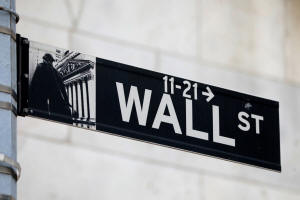Wall Street closes rollercoaster week sharply lower
 Send a link to a friend
Send a link to a friend
 [September 18, 2021] By
Stephen Culp [September 18, 2021] By
Stephen Culp
NEW YORK (Reuters) - U.S. stocks ended
sharply lower in a broad sell-off on Friday, ending a week buffeted by
strong economic data, corporate tax hike worries, the Delta COVID
variant, and possible shifts in the U.S. Federal Reserve's timeline for
tapering asset purchases.
All three major U.S. stock indexes lost ground, with the Nasdaq
Composite Index's weighed down as rising U.S. Treasury yields pressured
market-leading growth stocks.
They also posted weekly losses, with the S&P index suffering its biggest
two-week drop since February.
"The market is struggling with prospects for tighter fiscal policy due
to tax increases, and tighter monetary policy due to Fed tapering," said
David Carter, chief investment officer at Lenox Wealth Advisors in New
York.
"Equity markets are also a little softer due to today's weak Consumer
Sentiment data," Carter added. "It's triggering concerns that the Delta
variant could slow economic growth."

A potential hike in corporate taxes could eat into earnings also weigh
on markets, with leading Democrats seeking to raise the top tax rate on
corporations to 26.5% from the current 21%.
While consumer sentiment steadied this month it remains depressed,
according to a University of Michigan report, as Americans postpone
purchases while inflation remains high.
Inflation is likely to be a major issue next week, when the Federal Open
Markets Committee holds its two-day monetary policy meeting. Market
participants will be watching closely for changes in nuance which could
signal a shift in the Fed's tapering timeline.
"It has been a week of mixed economic data and we are focused clearly on
what will come out of the Fed meeting next week," said Bill Northey,
senior investment director at U.S. Bank Wealth Management in Helena,
Montana.
The Dow Jones Industrial Average fell 166.44 points, or 0.48%, to
34,584.88; the S&P 500 lost 40.76 points, or 0.91%, at 4,432.99; and the
Nasdaq Composite dropped 137.96 points, or 0.91%, to 15,043.97.
[to top of second column] |

A street sign for Wall Street is seen outside of the New
York Stock Exchange (NYSE) in New York City, New York, U.S.,
June 28, 2021. REUTERS/Andrew Kelly/File Photo

The S&P 500 ended below its 50-day moving average, which in recent history has
proven a rather sturdy support level.
Of the 11 major sectors in the S&P 500, all but healthcare ended in the red,
with materials and utilities suffering the biggest percentage drops.
COVID vaccine manufacturers Pfizer Inc and Moderna Inc dropped 1.3% and 2.4%,
respectively, as U.S. health officials moved the debate over booster doses to a
panel of independent experts.
U.S. Steel Corp shed 8.0% after it unveiled a $3 billion mini-mill investment
plan.
Robinhood Markets Inc rose 1.0% after Cathie Wood's ARK Invest bought $14.7
million worth of shares in the trading platform.
Volume and volatility spiked toward the end of the session due to "triple
witching," which is the quarterly, simultaneous expiration of stock options,
stock index futures, and stock index options contracts.
Volume on U.S. exchanges was 15.51 billion shares, compared with the 9.70
billion average over the last 20 trading days.
Declining issues outnumbered advancing ones on the NYSE by a 1.97-to-1 ratio; on
Nasdaq, a 1.00-to-1 ratio favored advancers.
The S&P 500 posted seven new 52-week highs and two new lows; the Nasdaq
Composite recorded 67 new highs and 82 new lows.
(Reporting by Stephen Culp; Additional reporting by Krystal Hu in New York and
Ambar Warrick in Bengaluru; Editing by Richard Chang)

[© 2021 Thomson Reuters. All rights
reserved.] Copyright 2021 Reuters. All rights reserved. This material may not be published,
broadcast, rewritten or redistributed.
Thompson Reuters is solely responsible for this content. |